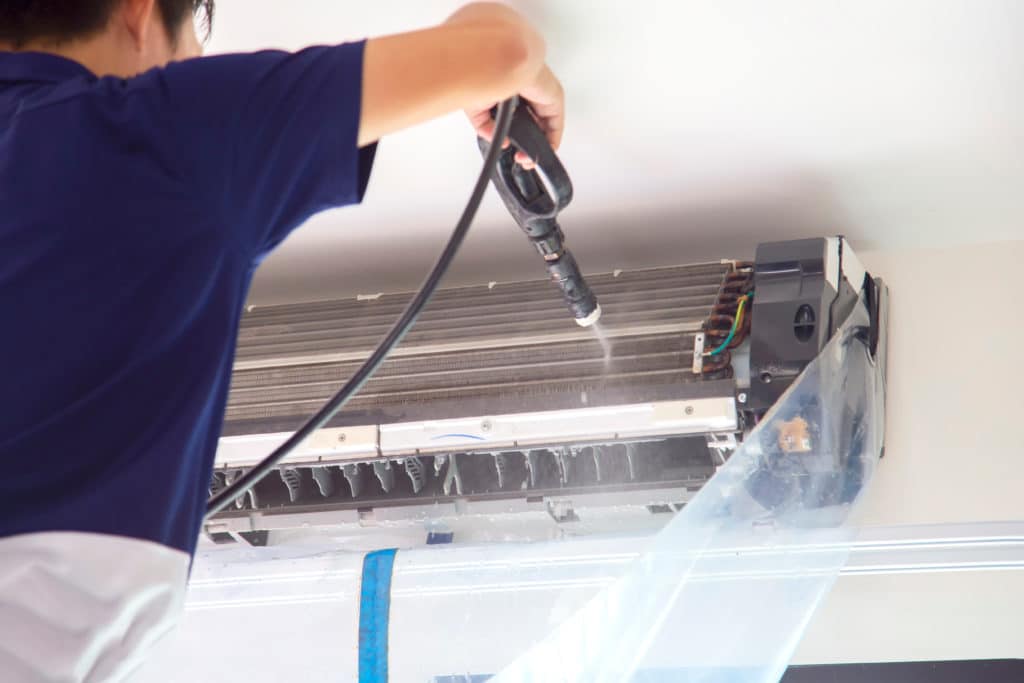As a diligent homeowner, taking care of your mini-split system is essential to ensuring its efficiency and longevity. One vital aspect of maintenance is cleaning the drain line, which prevents issues like mold growth, algae buildup, and potential water damage. In this step-by-step guide, we’ll walk you through the process of cleaning your mini-split drain line to maintain optimal performance and indoor air quality.
Step 1: Ensuring Safety First – Turn Off the AC
Prioritize your safety by turning off the air conditioner. Locate the service panel and switch off the breaker controlling the AC unit. Disabling the circuit connection prevents any electrical current from flowing through the system while you work on it.
Step 2: Seal the Drain Line with a Damp Towel
Creating an airtight seal around the drain line is crucial for effective cleaning. Grab a damp towel and wrap it around the drainpipe, which will ensure a secure fit for the vacuum hose and prevent any air leaks during the cleaning process.
Step 3: Use a Vacuum to Clear the Drain Line
Attach a vacuum hose to the drain line and power on the vacuum. Allow it to run for a short duration to dislodge and remove any debris that might be obstructing the drain pipe. You’ll likely notice discolored water, indicating the removal of accumulated particles and potential blockages.
Step 4: Access the Indoor AC Unit
Before proceeding, ensure that the AC unit’s power is turned off. Consult the user manual to understand how to remove the front panel. Typically, plastic snaps on the bottom side of the panel can be pressed to release the air filters. Vacuum the filters before reinserting them. Proceed to unscrew and remove the plastic cover.
Step 5: Locate and Inspect the Drain Pipe
With the front panel removed, you’ll have access to the drain pipe situated at the base of the indoor unit. Locate the seal connecting the air conditioner’s drain to the drain pipe. Remove any insulation or tape covering the joint. Keep a bucket ready to catch any water that might leak during the separation of the joints.
Step 6: Thoroughly Clean the Indoor AC Unit
Utilize a drain brush to clean the drain line thoroughly. Insert the brush into the drain and move it back and forth to dislodge accumulated dirt. For an extra level of cleaning, you can pour a small amount of bleach down the drain to eliminate germs. Wrap a soaked towel around the drain, connecting it to the vacuum hose to catch debris while running the vacuum.
Step 7: Reassemble the Components
Reconnect the split AC drain pipe and reattach the inside panel using the appropriate snaps. Replace the outside panel and secure the previously removed screws. Reinsert the cleaned air filters and attach the top cover to complete the reassembly process.
Frequency Of Cleaning
Maintaining your mini split system involves cleaning both indoor and outdoor drain lines regularly. It is advisable to clean the drain lines every four to six weeks to ensure optimal performance and prevent blockages.
Identifying Clogs

Keep an eye out for signs of a clogged drain line, including musty odors, water accumulation near the indoor unit, water damage in nearby areas, ineffective cooling, and AC system malfunctions. If you notice any of these symptoms, it’s time to inspect and clean the drain line.
Professional Cleaning Costs

While the cost of cleaning a mini split drain line can vary based on several factors, hiring a certified HVAC professional for the task typically ranges between $200 and $400.
Effective Cleaning Solutions
You can use various solutions, such as bleach, vinegar, hydrogen peroxide, or antibacterial soap mixed with warm water, to clean your mini split drain line. Pouring one cup of any of these solutions down the drain line followed by a thorough flush with water can effectively eliminate contaminants.

In Conclusion
Regularly cleaning your mini split drain line is a vital aspect of maintaining the efficiency and lifespan of your HVAC system. By following this comprehensive guide, you can ensure that your mini split remains free from mold, algae, and blockages, thereby providing you with consistent cooling and heating performance throughout the seasons. Remember to prioritize safety, follow the steps meticulously, and seek professional assistance if needed for a hassle-free maintenance routine.





GIPHY App Key not set. Please check settings